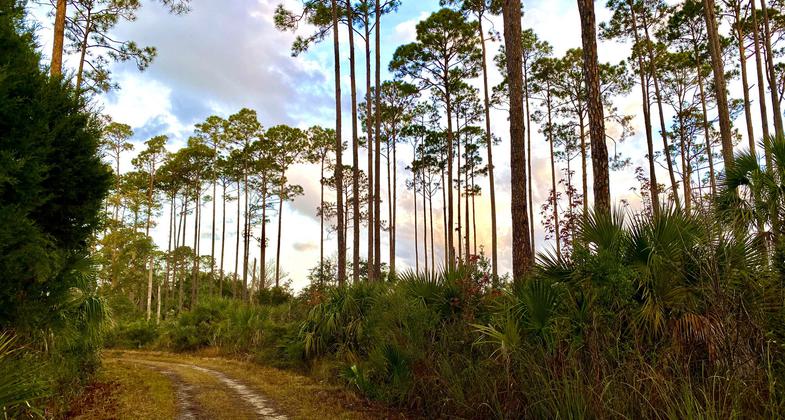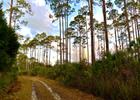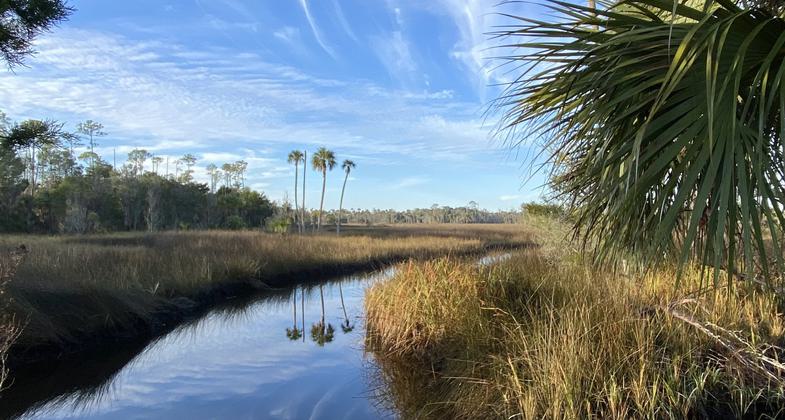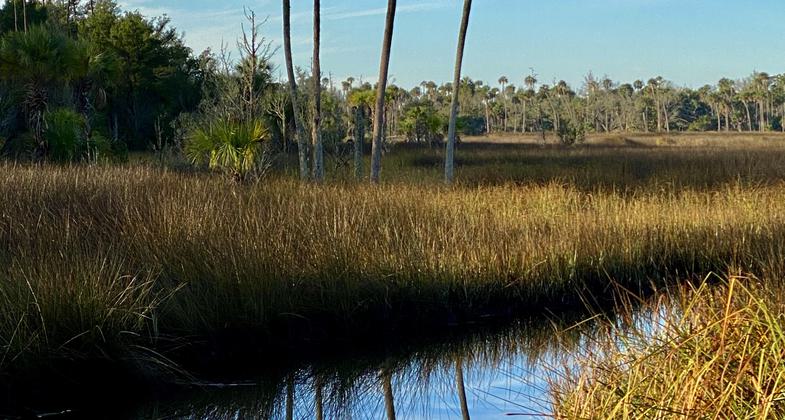Seven Mile Loop Trail
check with the trail manager for updated details before visiting.
Seven Mile Loop Trail
State
Backcountry Trail
- Length
7.25 miles
- Elevation Gain
--
- Route Type
Loop
- Length
7.25 miles - Elevation Gain
-- - Route Type
Loop
This 7.25-mile long trail offers hikers and cyclists access to some of Florida's unique habitats such as salt marsh, tidal creeks, coastal estuary, oak hammock, and pine flatwoods as they follow two-track limestone paths left from historic uses of this land. The varied habitats allow a plethora of wildlife to flourish year-round, including several rare and endangered species. The trail is tidally influenced and can be wet or flooded at times.

Seven Mile Loop Trail at Sunrise. Photo by Heather Nagy

Natures artwork. Photo by Heather Nagy.

Palm reflections. Photo by Heather Nagy.

Ibis in flight. Photo by Heather Nagy.

Trailhead entrance and kiosk. Photo by Olivia Morrison.

Trailhead and parking. Photo by Olivia Morrison.

The trail passes through a variety of Florida habitats. Photo by Olivia Morrison.

The trail passes through a variety of Florida habitats. Photo by Michael Grier.

Seven Mile Loop Trailhead

Saltmarsh along the trail
Location: In Crystal River Preserve State Park in Crystal River, Florida
- States: Florida
- Counties: Citrus
- Cities/Townships: Crystal River, Florida
The Seven Mile Loop Trail in the Crystal River Preserve State Park offers hikers and cyclists the opportunity to explore the "Real Florida" as they travel through diverse coastal habitats. The trail is primarily on limestone two-tracks remaining from historic uses of the land, including logging, limestone mining, turpentine production, and ranching which occurred before the land became a Florida State Park in 2004. It is suitable for hiking, running, mountain biking, and gravel grinding. It crosses several freshwater tidal creeks that offer opportunities for wildlife viewing, photography, or quiet appreciation of the extraordinary beauty of this unique place.
The scenery on the loop is extremely varied, from wide-open views across miles of sawgrass and needle rush, salt marsh, to shady tree tunnels formed by the spreading limbs of Live Oak trees. It's never boring, and always scenic.
Elevation changes on this trail are measured in inches, not feet, but those subtle rises and dips bring about noticeable differences in vegetation. The trail passes through a variety of Florida habitats, including pine flatwoods, oak hammocks, salt marsh, creeks, and freshwater swamps. This variety allows for a vast array of wildlife to flourish. Hikers and cyclists regularly see deer, otters, alligators, squirrels, rabbits, crabs, tortoises, turtles, and armadillos. Wild hogs, perhaps descendants of escaped livestock from Hernando de Soto's 1539 exploration of the area, are also occasionally spotted. Quiet, early hikers are often elated to get a glimpse of a bobcat or to see footprints of deer in the soft mud. The imperiled ornate diamondback terrapin is sometimes seen sunning on exposed limestone banks of the tidal creeks, and elusive indigo snakes are a rare treat in the upland areas.
This trail is a designated stop on the Great Florida Birding & Wildlife Trail and is a birding hotspot year-round, but especially during spring and fall migrations. Even those who are not birders can enjoy many kinds of large wading birds such as herons, egrets, and ibises, and upland species such as turkeys and Sandhill Cranes. Bald Eagles nest in the preserve and are often seen soaring above the trail or perching in pines. The startlingly pink Roseate Spoonbill is a favorite of hikers.
With its location on the coast of the Gulf of Mexico, this trail is tidally influenced and can be wet, muddy, or flooded at times, especially during the summer (May through September). It remains open every day (except when under hurricane warning) for those who want an adventure.
There are several benches along the trail to stop for a rest or to take in the vast scenery. There are no restrooms, and there is no potable water on the trail; the closest facilities are at the State Park Office on Sailboat Avenue. It is recommended that hikers and cyclists bring or wear insect repellent and sunscreen, carry a cell phone, and bring plenty of water. Although the trail is basically level, hikers should wear sturdy shoes. This trail is a popular destination during the dry, cooler, winter months, but in all seasons, hikers need to be prepared for hot, humid afternoons, and possible afternoon thunderstorms. Most hikers take 3 to 5 hours to complete the loop, and gravel bikers take 1 to 2 hours.
The Seven Mile Loop Trail passes through areas where ancient people made their camps for more than 12,000 years. Although most are unmarked, more than 100 archaeologically significant sites are protected within the boundaries of CRPSP. These include pre-Columbian shell middens and campsites. Florida State law prohibits digging for or collecting artifacts on state-owned lands. For more information about the archaeology of the area, visitors are encouraged to visit the museum and mounds of Crystal River Archaeological State Park, adjacent to the preserve.
Accessibility Information
No text provided.
Allowed Uses:
Bicycling Dogs, on leash Hiking/WalkingOther Activities
- Heritage and history
- Wildlife viewing / observation
Public Contact
Barbara RobertsFlorida Department of Environmental Protection
3266 N. Sailboat Avenue
Crystal River, FL 34428
[email protected] • (352)228-6028
Contact the trail manager for current maps and visiting details.
More Details
- Elevation (low): 3
- Elevation (high): 3
- Elevation (cumulative): --
- Part of a Trail System? No
- National Designations: Stop on the Great Florida Birding & Wildlife Trail
- Surface (primary): Rock, crushed
- Surfaces (additional): Sand, Soil
- Tread Width (average): 127"
- Tread Width (minimum): 127
- Running length (minimum): --
- Tread Grade (average, percent): --
- Tread Grade (maximum): 4
- Running length (maximum): --
- Cross-slope (average, percent): 0
- Cross-slope (maximum): --
- Running length (maximum): --
- Certified as an NRT
Jun 2, 2022





